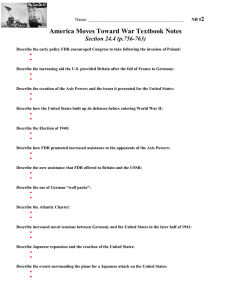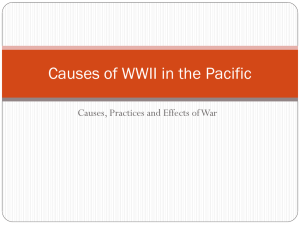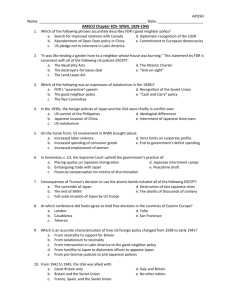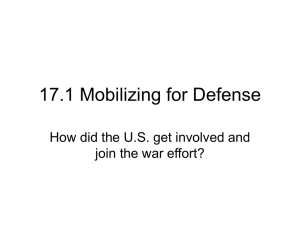World War II APUSH ch. 25 part 1
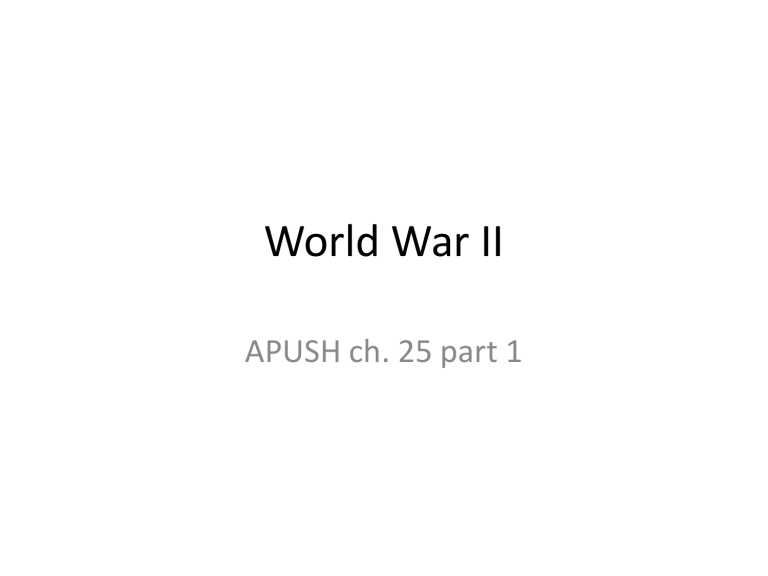
World War II
APUSH ch. 25 part 1
Europe’s War
• Background?
– Fascism in Germany & Italy
– Militarism in Japan
– territorial expansion by all 3
– Munich Conference – Chamberlain
• appeasement
• What starts the war?
– Germany’s invasion of Poland in 1939
• Who’s who?
– Allies = Britain, France (briefly) and USSR
– Axis = Germany, Japan, and Italy
• America’s role?
– Neutral until December 1941
• Why?
– WWI still fresh in America’s mind (isolationist)
– Companies selling to Britain and Nazi Germany
American Neutrality
• How did the US affirm its neutrality?
– Neutrality Acts – 1935-7
• Illegal to sell arms/loan $ to nations at war
• Illegal for US citizens to travel on ships belonging to nations at war
– St. Louis – ship w/ Jewish refugees turned back in Florida
– Who wanted to stay neutral?
• Pacifists opposed to war
• Progressive reformers who thought war would curb US reforms
• Right-wing sympathizers who sided w/ fascists
The Gathering Storm
• What steps did the US take that moved the nation closer to war?
– 1938-9: FDR asks Congress for massive increase in defense spending
– US plans to build extra 20,000 planes/year
– Cash & carry – amendment to Neutrality Acts
• US could sell arms to nations who paid cash and carried arms away in own ships
• Would favor British, who controlled Atlantic
– 1940 – peacetime draft
– “destroyers for bases” swap w/ Britain
– Lend-Lease Act – 1941 – to loan $ to nations whose defense was vital to US interests
• Like loaning a hose to neighbor to put out a fire
– US Navy convoys British cargo ships
– US military sets up in Iceland, Greenland
– Atlantic Charter – document condemning international aggression
– Reuben James – merchant ship sunk by U-boats
• US begins arming merchant ships
US – Japanese Relations
• What were Japan’s intentions?
– Build a Pacific empire
• Living space, raw materials for
Japanese industry
– Relations b/w US and Japan?
• Distrust – US saw Japanese hegemony in Pacific as threatening to Open Door policy, and vice versa
• Racism on both sides
• US ends sale of metal, fuel to Japan
• US freezes all Japanese business assets in US after invasion of Indochina
• US expects attack, likely in Philippines
• Attack on Pearl Harbor on 12-7-41
Early War in Europe
• Before US intervention:
– War not going well for Allies
– Nazis take virtually all of mainland Europe by 1941
– Low point = battle of Dunkirk – British troops in France backed up to English
Channel
• Britain uses military & civilian ships to evacuate over 100,000 troops – France falls
– Battle of Britain – air war over Britain
• Constant bombing every night of civilian targets
• British radar and RAF push back Luftwaffe
• Hitler gives up trying to bomb Britain out of war
• After 1941
– German U-boats sinking cargo ships on Atlantic
– Allies losing war
– 1941 – Hitler breaks pact w/ USSR
– Invades USSR
• Nazis wage total war vs. USSR
(communists, Jews, slavs, etc.)
• Lay siege to major cities
Mobilization
•
How did US prepare for war?
– Organizing – gov’t re-organized for war effort
• Creation of Joint Chiefs of Staff (military advisory)
• Creation of OSS for spying & covert ops (predecessor to
CIA)
• New agencies to oversee industrial production
– War Production Board allocates materials, contracts
– War Manpower Commission – mobilizes people for military, industry, agriculture
– Nat’l War Labor Board – mediates labor disputes
– Office of Price Admin. – price controls, rationing
Mobilization
•
• How did the US build its war arsenal?
– Convert industry from peace-time to wartime production
– Civilian factories build war goods (like Ford)
– By 1942, 1/3 of US industry committed to wartime production
• US industrial output larger than Germany, Italy, Japan combined
– Innovation – new ways of producing goods faster, invented synthetic rubber, etc.
– Manpower - # of civilian fed. Employees tripled
• Industrial ranks swelled
• Industry came to south
• Retirees went back to work
• Women & minorities in factories
– Spending – defense spending increased 500% from 1940 to 1945
– Consensus – labor and management set aside differences
• Worker wages rose, as did corporate profits
• Union membership almost doubled
• Unions limited wage requests, negotiated better benefits instead
• Exception – UMW went on strike several times
• War Labor Disputes Act – pres can take over industries if threatened
– Rationing – gas, rubber, silk, food, etc.
• Nylon as silk substitute
– Sale of war bonds
Science of War
•
US scientists helped – how?
– Better weapons systems
– Computers to make faster targeting decisions
– Medical tech. to help battlefield surgery
– Insecticides to help w/ war in Pacific
– Work on atomic bomb – Manhattan Project
• Produced many by-products like semiconductors and transistors
Propaganda
•
How did US drum up support for war effort?
– Posters encouraging joining military, war bonds, rationing
– Office of Censorship censored news, mail
– Office of War Information oversaw propaganda campaigns
– Hollywood made patriotic movies (John Wayne)
Diplomacy
• US naturally sided w/ Britain
• What about USSR?
– US and Britain set aside differences w/ USSR
– Agreed to “defeat Hitler first” strategy
– USSR wanted second front in Europe
• Britain wanted to protect interests in Mid-east (oil)
• Invaded N. Africa instead in 1942 (Operation Torch)
– El Alamein (Egypt)
– Later invasion of Italy (Anzio key battle)
Diplomacy
•
Big Three
– FDR, Churchill, Stalin
– Main meetings
• Casablanca – 1943 – FDR and Churchill decided to attack Italy before France
• Cairo – 1943 – FDR, Churchill, Chiang Kai-shek promise
Taiwan and Manchuria to China after war
• Tehran – 1943 – Big 3 agree to divide postwar Germany and reparations
– Stalin agrees to help vs. Japan after Germany defeated
• 1945 – Yalta – details later
War in Pacific
•
By 1941 Japan had massive empire in Pacific
•
US adopts “island hopping” strategy
– Nimitz – naval commander
– MacArthur = army commander
Japanese Brutality
•
